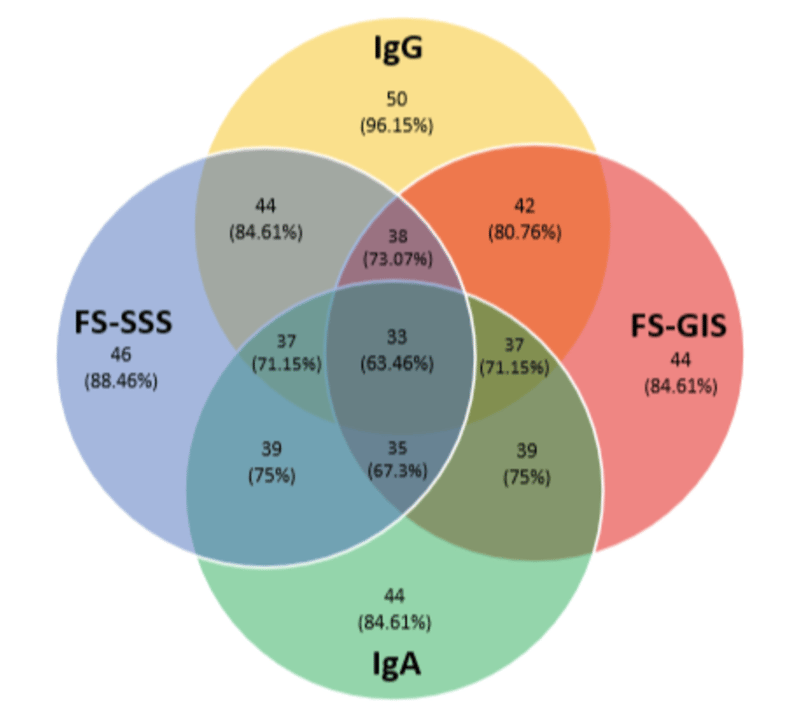Vibrant Research Spotlight: Food Sensitivity Clinical Trial
Food sensitivities can significantly impact health, causing symptoms like gastrointestinal distress, skin issues, and fatigue.
Diagnosing and treating food sensitivities is challenging due to their non-specific nature and the delayed onset of symptoms.
Traditional methods often fall short, highlighting the need for advanced testing.
Typically, patients suffering from food sensitivity are placed on elimination diets. However, there hasn’t been much research supporting this treatment method—until now.
To address this, Vibrant Wellness conducted a groundbreaking clinical trial to assess whether effective food sensitivity testing and the subsequent implementation of a personalized elimination diet could improve patients’ symptoms and overall well-being.
This trial provides unique clinical research focused on food sensitivity testing, aiming to fill a crucial gap in the field.
Table of Contents
Novel Clinical Trial on Food Sensitivity Testing

“Personalized Food Elimination Diet: A Clinical Trial Based on Food Sensitivity Assessment” is a 2024 preprint study published in Research Square, conducted by the Vibrant research team.
The trial aimed to evaluate the effectiveness of personalized elimination diets guided by serological food sensitivity assessments.
This single-arm, interventional study involved 52 participants aged 18 to 75 who reported gastrointestinal (GI) symptoms.
The primary objective was to determine whether serological testing for food sensitivities, followed by a personalized elimination diet, would improve participants' symptoms and overall well-being.
The study specifically aimed to assess changes in GI symptoms, the participants' quality of life, and changes in IgG and IgA antibody levels.
Our research team recruited participants from eight healthcare practices registered as study sites for this multicenter trial.
Participant blood samples were tested for IgG and IgA antibodies against 262 food antigens using Vibrant's silicon-based peptide and protein microarray technology.
Advanced Technology and Personalized Interventions

Our research team conducted the study using the Food Sensitivity Test Complete and our eleven Food Zoomers, which assessed reactions at both the peptide and protein levels.
Based on test results, we created a personalized elimination diet for each participant, excluding foods they were reactive to.
Participants followed the diet for four weeks, and their symptoms were monitored weekly using the Food Sensitivity-Symptom Severity Scale (FS-SSS) and the Food Sensitivity-Quality of Life Questionnaire (FS-QoL). Physicians also evaluated participants' responses using the Food Sensitivity-Global Improvement Scale (FS-GIS).
The primary outcomes measured were the improvement in GI symptoms (as measured by FS-SSS), physician's assessment of participants' responses (FS-GIS), and changes in IgG and IgA antibody levels. Secondary outcomes included the effect of demographic parameters such as BMI, sex, and age on symptom improvement, as well as the impact on participants' quality of life, as measured by the FS-QoL.
Our team assessed symptom changes using the Wilcoxon Signed Rank Test and the Friedman test. Changes in antibody levels were calculated as the percent decrease between pre- and post-intervention concentrations. Demographic effects on outcomes were analyzed using similar statistical methods.
This robust study design allowed for a comprehensive evaluation of the impact of personalized elimination diets based on precise food sensitivity assessments, providing valuable insights into managing food sensitivities and improving patient health through personalized nutrition.
Key Findings: Clinical Significance in Managing Food Sensitivity Through Personalized Elimination Diets

Our clinical trial yielded significant and promising results:
One of the primary outcomes was that participants’ GI symptoms were significantly reduced.
Results showed that 88.46% of participants experienced a significant decrease in symptom severity from baseline to week four. This highlights the positive impact of personalized dietary interventions on GI distress.
Furthermore, the study assessed changes in IgG and IgA antibody titers, which are crucial markers for food sensitivities. Post-intervention, 96.15% of participants exhibited improved IgG levels, while 84.61% showed a decrease in IgA titers. These findings suggest that the elimination diet effectively reduced the immune response associated with food sensitivities, contributing to improved health outcomes.
The physicians’ evaluation of participants' responses, gauged using the Food Sensitivity-Global Improvement Scale (FS-GIS), further supported these results. According to FS-GIS scores, 84.61% of participants demonstrated notable improvements. Specifically, 17.31% of participants were rated as significantly improved, 36.53% as moderately improved, and 30.77% as slightly improved. Only a small fraction, 15.39%, showed no change or slight worsening of symptoms.
Additionally, the study explored the correlation between symptom improvement and demographic factors such as BMI, sex, and age. Both normal weight and overweight groups showed statistically significant symptom reduction from baseline to week four.
Women experienced significant improvements from weeks one to four, while men showed significant changes starting from week two. These findings indicate that personalized elimination diets are effective across different demographic groups, though the onset of symptom relief may vary.
Impact on Quality of Life
Quality of life, measured by the Food Sensitivity-Quality of Life Questionnaire (FS-QoL), improved for 57% of participants. Although the change was not statistically significant for the entire group, the reduction in FS-QoL scores for a majority of participants underscores how addressing food sensitivities can benefit well-being.
Summary of Key Findings

- 88.46% of participants experienced a significant decrease in symptom severity.
- 96.15% of participants showed improved IgG levels.
- 84.61% of participants exhibited reduced IgA titers.
- 84.61% of participants demonstrated notable improvements according to FS-GIS scores.
- Quality of life improved for 57% of participants.
Overall, the trial's key findings demonstrate the importance of personalized elimination diets in managing food sensitivities. By accurately identifying and eliminating reactive foods, participants experienced significant improvement in symptoms and antibody levels and substantial improvement in quality of life. These results provide evidence-based research in support of personalized dietary interventions to enhance health outcomes for individuals with food sensitivities.
Clinical Significance
The precision and comprehensiveness of Vibrant’s diagnostic tools enabled the clinical trial to gain significant insights into food sensitivities and their management through personalized elimination diets. Accurate identification of food sensitivities and tailored elimination diets led to significant improvements in participants' symptoms and overall well-being. This trial supports the use of diagnostic tools to identify food sensitivities, as well as the effectiveness of elimination diets guided by test results.
Food Sensitivity Testing Technology
%20(1)-1.png?width=800&height=406&name=Tickborne%20Diseases%20%20Advanced%20Detection%20Technology%20(800%20x%201200%20px)%20(1)-1.png)
The study utilized Vibrant's silicon-based peptide and protein microarray technology to measure IgG and IgA antibody responses to 262 food antigens. This approach enabled a detailed analysis of immune reactions to various foods, forming the basis for personalized elimination diets.
The peptide and protein microarrays used in the study offer several advantages over traditional testing methods:
- Testing for Multiple Antigens: Protein microarrays can test for multiple food antigens at once, ensuring a broad and accurate detection of sensitivities.
- High Sensitivity: By leveraging high-throughput screening, the technology could identify even low-level antibody responses, so no reactive food is overlooked. This high level of precision is crucial for developing effective elimination diets, as even small amounts of reactive foods can trigger symptoms in sensitive individuals.
- Enhanced Detection: The use of chemiluminescence-based assays further enhanced detection capabilities. Chemiluminescence allows for the identification of lower levels of antibodies compared to standard ELISA testing, improving the overall accuracy of results. This technology not only enhances the sensitivity of the tests but also reduces the likelihood of false negatives, ensuring that all relevant food sensitivities are identified.
- Automated Processing: The integration of Vibrant's proprietary software further streamlined the data analysis process. The software extracted raw chemiluminescent signals from the microarrays, converting them into quantifiable data through normalization and correction techniques. This automated analysis ensures consistency and reliability in the test results, providing a solid foundation for the study's dietary interventions.
Vibrant Food Sensitivity Panels

Vibrant Food Sensitivity tests are blood panels that detect sensitivities to up to 209 different foods. The panels assess different immune responses to whole, raw, water-soluble proteins commonly consumed to determine one's risk for negative food reactions. There are several panel options:
- Food Sensitivity Profile 1: Tests 96 foods.
- Food Sensitivity Profile 2: Tests 84 foods.
- Food Sensitivity Complete: Tests 209 foods.
Each panel also comes with two different options for antibody testing: IgA and IgG or IgG4 and C3D. Combining both options provides a full assessment of food sensitivity by measuring IgA, IgG, IgG4 antibodies, and C3D together.
Vibrant Food Zoomers

In addition to the Food Sensitivity panels, the trial also utilized Vibrant’s Food Zoomers to detect food reactions.
The Food Zoomers are blood tests that use IgA and IgG antibodies to measure immune system reactivity to small peptides formed when whole proteins are broken down by digestion—unlike the Food Sensitivity tests, which measure whole proteins.
Vibrant currently offers nine different Food Zoomer tests, including:
- Wheat Zoomer
- Corn Zoomer
- Dairy Zoomer
- Egg Zoomer
- Grain Zoomer
- Lectin Zoomer
- Soy Zoomer
- Peanut Zoomer
- Nut Zoomer
The tests provide detailed reports of food reactions, helping patients understand which foods to avoid and which might be safely reintroduced over time.
Overall, food sensitivity testing measures various antibody levels against a wide array of food antigens, providing a detailed profile of an individual's immune response to specific foods.
This comprehensive assessment allows for tailored dietary plans that address each patient's unique sensitivities.
Through these advanced methodologies, our clinical trial demonstrated successful implementation of test-based elimination diets and led to improved outcomes.
By incorporating Vibrant food sensitivity testing into their practice, providers can offer patients a scientifically validated tool for identifying food sensitivities and developing personalized dietary interventions.
The test's comprehensive nature ensures that patients receive accurate and actionable insights into their food sensitivities, enabling them to make informed dietary choices and achieve better health outcomes.
Benefits of Personalized Nutrition

The clinical trial highlighted the significant advantages of personalized nutrition, particularly through personalized elimination diets based on food sensitivity assessments. This approach offers numerous benefits for patients, leading to improved health outcomes and overall well-being.
- Symptom Reduction: One of the most immediate benefits of personalized nutrition is the reduction of symptoms associated with food sensitivities. In the trial, 88.46% of participants experienced a significant decrease in gastrointestinal (GI) symptoms. By accurately identifying and eliminating reactive foods, patients saw dramatic improvements in conditions like bloating, abdominal pain, and irregular bowel movements. This direct and targeted approach provides quick relief, enhancing the patient's quality of life.
- Immune System Impact: Personalized elimination diets not only alleviate symptoms but also positively impact the immune system. The trial demonstrated that 96.15% of participants showed improved specific IgG antibody levels, and 84.61% exhibited decreased specific IgA levels. By reducing the immune response to specific food antigens, personalized diets help mitigate chronic inflammation, which is often linked to a variety of health issues, including autoimmune diseases and chronic GI disorders.
- Quality of Life: The improvement in physical symptoms directly contributes to a better quality of life. The Food Sensitivity-Quality of Life Questionnaire (FS-QoL) used in the trial revealed that 57% of participants experienced enhanced well-being post-intervention. Participants reported higher energy levels, better mood, and overall improvements in daily functioning. Personalized nutrition helps patients regain control over their health, enabling them to enjoy a more active and fulfilling life.
- Long-Term Health Benefits: Beyond immediate symptom relief, personalized nutrition can offer long-term health benefits. By continuously avoiding foods that trigger adverse reactions, patients can maintain a state of reduced inflammation and improved immune function. This proactive approach to health can potentially prevent disease development. The trial's findings suggest that long-term adherence to personalized dietary recommendations can lead to ongoing health improvements.
- Informed Dietary Choices: Personalized nutrition provides patients with specific information about their food sensitivities. Thus, they can make informed dietary choices, avoiding foods that negatively impact their health. This fosters a sense of control and confidence, encouraging patients to take an active role in managing their health. The personalized elimination diet becomes a practical tool for patients to navigate their dietary habits effectively.
- Holistic Health Management: Additionally, personalized nutrition addresses health issues holistically by considering the unique responses of each individual. This tailored approach ensures that dietary interventions are specific to the patient's needs, rather than adopting a one-size-fits-all strategy. The trial's results underscore the importance of this individualized approach, showing that personalized elimination diets can lead to comprehensive health improvements, including better skin health, enhanced cognitive function, and improved digestive health.
The benefits of personalized nutrition, as demonstrated in the clinical trial, highlight the transformative potential of this approach. By leveraging advanced food sensitivity testing and personalized dietary interventions, healthcare providers can offer targeted and effective solutions for managing food sensitivities. This not only improves patient outcomes but also promotes a proactive and informed approach to health and wellness.
The Bottom Line

Our groundbreaking clinical trial highlights the critical role of personalized nutrition in managing food sensitivities. With Vibrant's advanced testing technology, you can precisely identify food sensitivities and implement effective dietary interventions. This approach not only alleviates symptoms but also significantly enhances overall health and well-being.
Regulatory Statement:
The general wellness test intended uses relate to sustaining or offering general improvement to functions associated with a general state of health while making reference to diseases or conditions. This test has been laboratory developed and its performance characteristics determined by Vibrant America LLC and Vibrant Genomics, a CLIA-certified and CAP-accredited laboratory performing the test. The lab tests referenced have not been cleared or approved by the U.S. Food and Drug Administration (FDA). Although FDA does not currently clear or approve laboratory-developed tests in the U.S., certification of the laboratory is required under CLIA to ensure the quality and validity of the test By
By



